Human Resource Management Report: IHG, Legislation, Recruitment
VerifiedAdded on 2020/11/23
|10
|2586
|442
Report
AI Summary
This report provides a comprehensive overview of Human Resource Management (HRM), focusing on its purpose and functions within organizations. It delves into the core responsibilities of HRM, including recruitment and selection, orientation, employee relations, and training and development. The report analyzes the strengths and weaknesses of internal and external recruitment approaches, offering insights into their impact on businesses like the Intercontinental Hotel Group (IHG). Furthermore, it highlights the importance of employee relations in influencing HRM decision-making, emphasizing strategies for fostering positive workplace dynamics. The report also examines the elements of employee legislation and its impact on HRM, covering aspects such as equality, data protection, health and safety, working time, wage regulation, and civil liberties. Through this analysis, the report underscores the critical role of HRM in managing employees and contributing to organizational success. The report concludes by summarizing the key findings and emphasizing the importance of effective HRM practices.
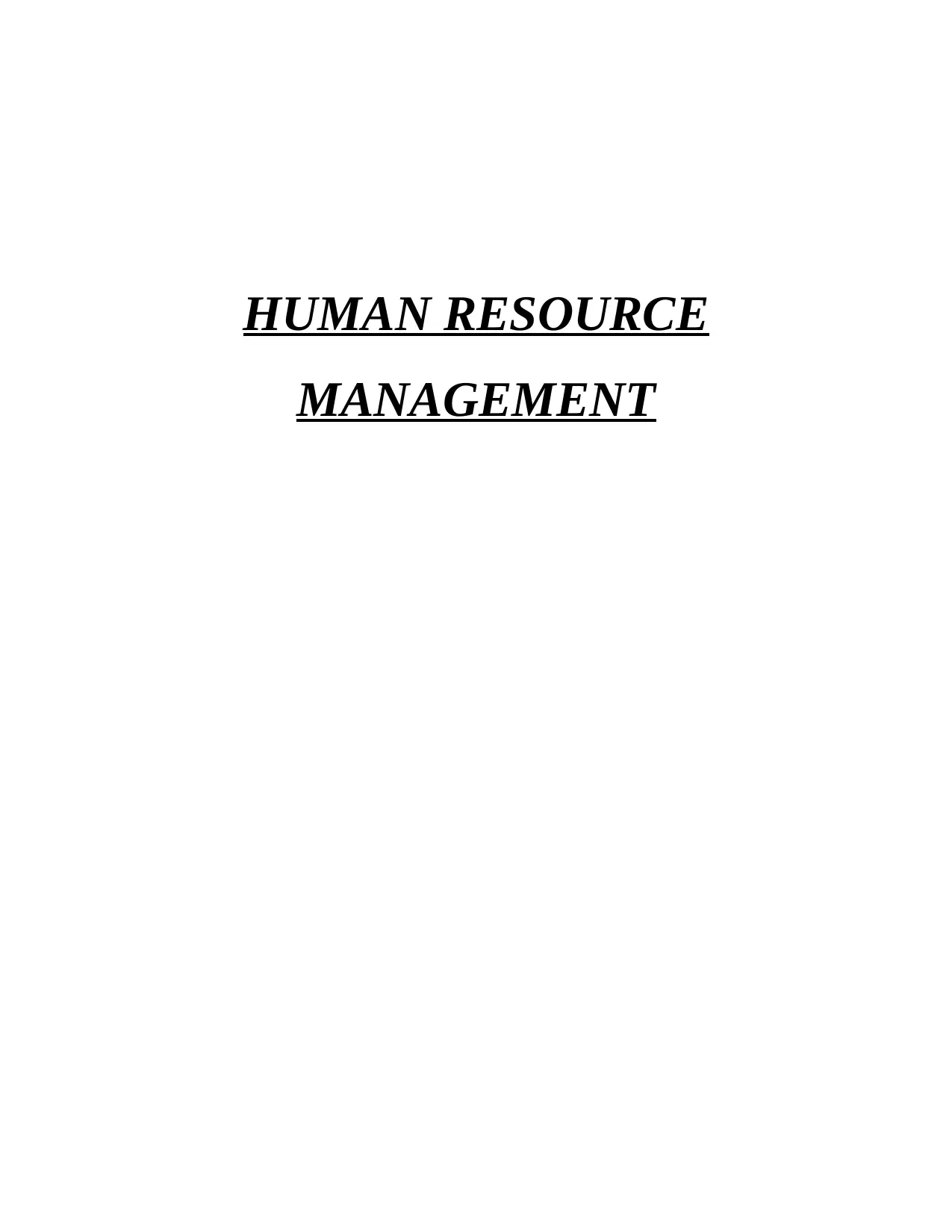
HUMAN RESOURCE
MANAGEMENT
MANAGEMENT
Paraphrase This Document
Need a fresh take? Get an instant paraphrase of this document with our AI Paraphraser
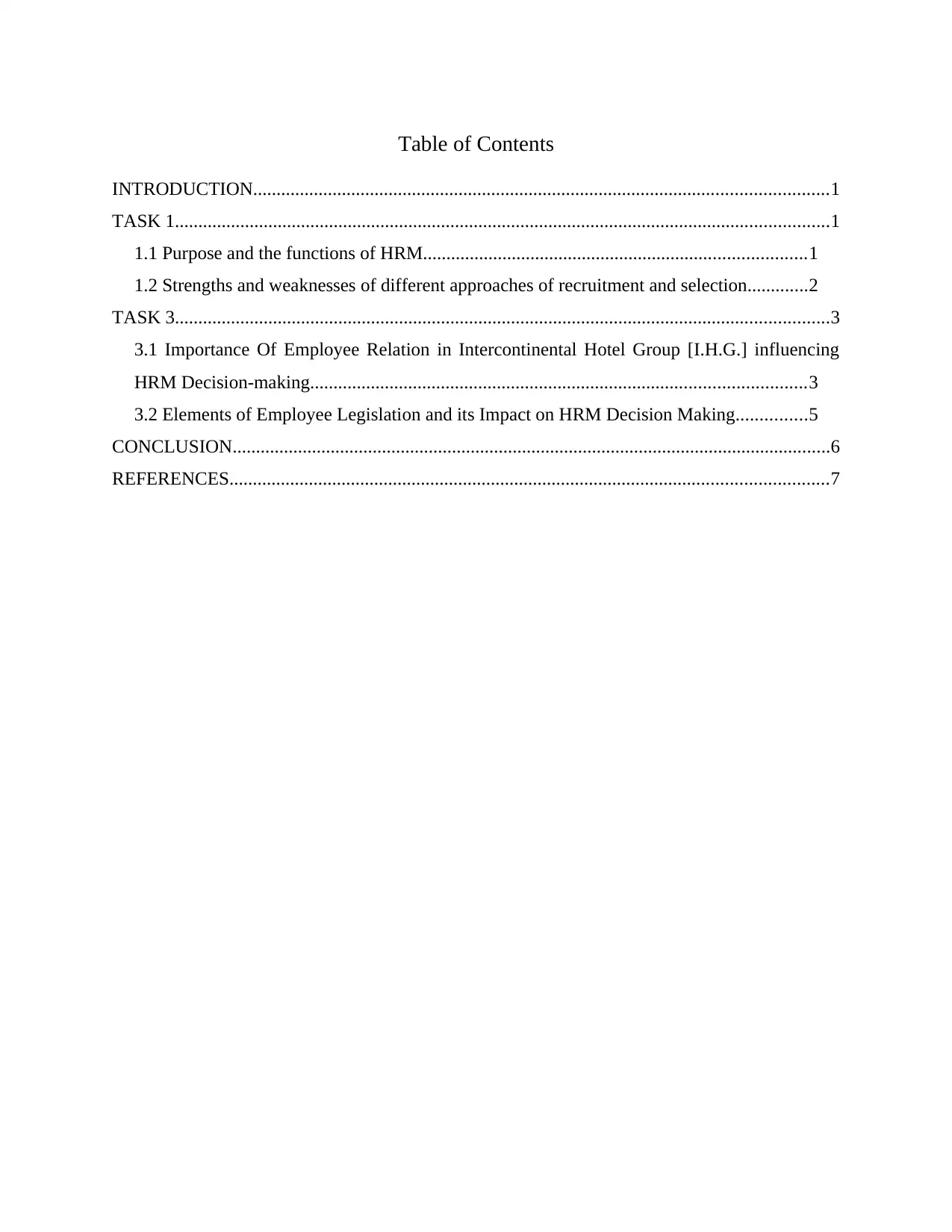
Table of Contents
INTRODUCTION...........................................................................................................................1
TASK 1............................................................................................................................................1
1.1 Purpose and the functions of HRM..................................................................................1
1.2 Strengths and weaknesses of different approaches of recruitment and selection.............2
TASK 3............................................................................................................................................3
3.1 Importance Of Employee Relation in Intercontinental Hotel Group [I.H.G.] influencing
HRM Decision-making..........................................................................................................3
3.2 Elements of Employee Legislation and its Impact on HRM Decision Making...............5
CONCLUSION................................................................................................................................6
REFERENCES................................................................................................................................7
INTRODUCTION...........................................................................................................................1
TASK 1............................................................................................................................................1
1.1 Purpose and the functions of HRM..................................................................................1
1.2 Strengths and weaknesses of different approaches of recruitment and selection.............2
TASK 3............................................................................................................................................3
3.1 Importance Of Employee Relation in Intercontinental Hotel Group [I.H.G.] influencing
HRM Decision-making..........................................................................................................3
3.2 Elements of Employee Legislation and its Impact on HRM Decision Making...............5
CONCLUSION................................................................................................................................6
REFERENCES................................................................................................................................7
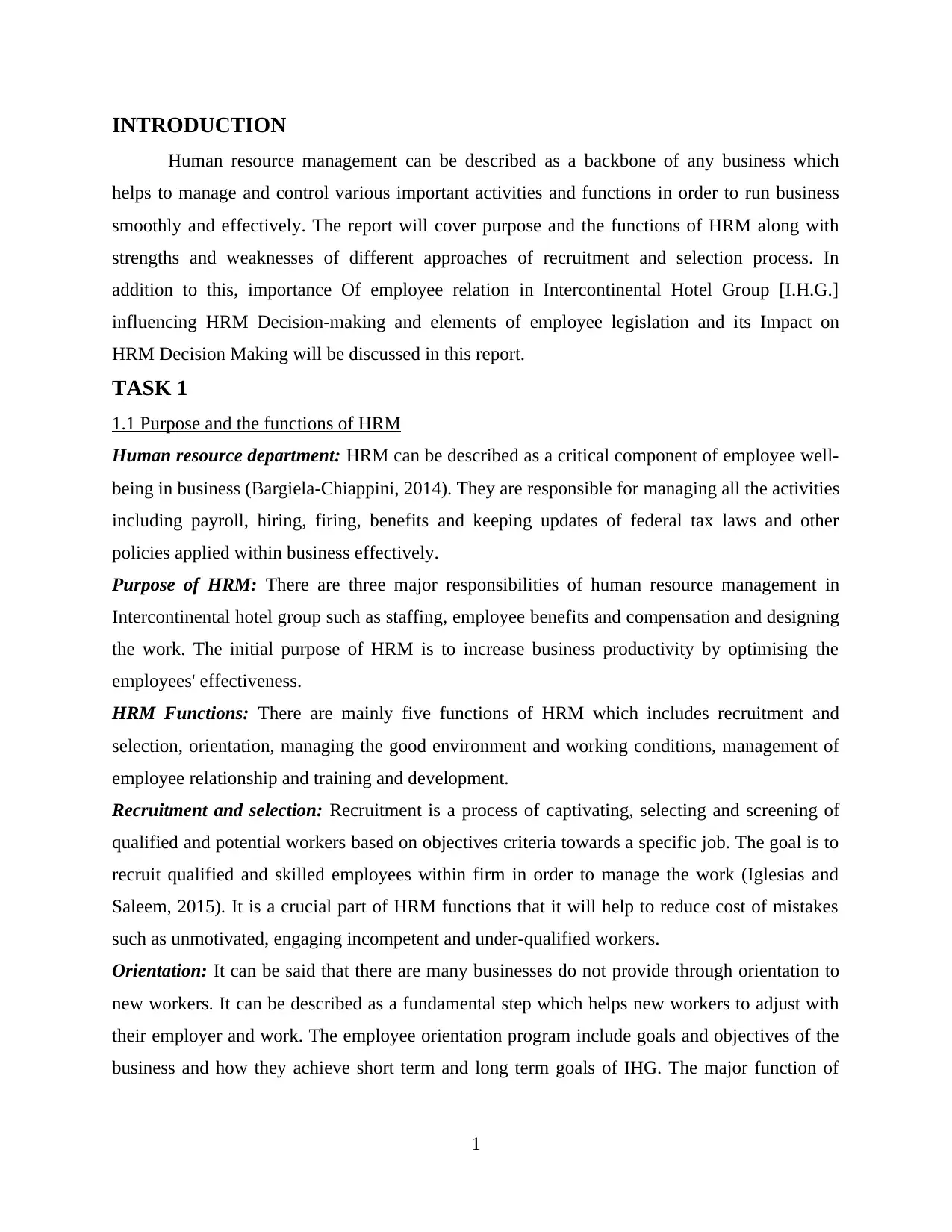
INTRODUCTION
Human resource management can be described as a backbone of any business which
helps to manage and control various important activities and functions in order to run business
smoothly and effectively. The report will cover purpose and the functions of HRM along with
strengths and weaknesses of different approaches of recruitment and selection process. In
addition to this, importance Of employee relation in Intercontinental Hotel Group [I.H.G.]
influencing HRM Decision-making and elements of employee legislation and its Impact on
HRM Decision Making will be discussed in this report.
TASK 1
1.1 Purpose and the functions of HRM
Human resource department: HRM can be described as a critical component of employee well-
being in business (Bargiela-Chiappini, 2014). They are responsible for managing all the activities
including payroll, hiring, firing, benefits and keeping updates of federal tax laws and other
policies applied within business effectively.
Purpose of HRM: There are three major responsibilities of human resource management in
Intercontinental hotel group such as staffing, employee benefits and compensation and designing
the work. The initial purpose of HRM is to increase business productivity by optimising the
employees' effectiveness.
HRM Functions: There are mainly five functions of HRM which includes recruitment and
selection, orientation, managing the good environment and working conditions, management of
employee relationship and training and development.
Recruitment and selection: Recruitment is a process of captivating, selecting and screening of
qualified and potential workers based on objectives criteria towards a specific job. The goal is to
recruit qualified and skilled employees within firm in order to manage the work (Iglesias and
Saleem, 2015). It is a crucial part of HRM functions that it will help to reduce cost of mistakes
such as unmotivated, engaging incompetent and under-qualified workers.
Orientation: It can be said that there are many businesses do not provide through orientation to
new workers. It can be described as a fundamental step which helps new workers to adjust with
their employer and work. The employee orientation program include goals and objectives of the
business and how they achieve short term and long term goals of IHG. The major function of
1
Human resource management can be described as a backbone of any business which
helps to manage and control various important activities and functions in order to run business
smoothly and effectively. The report will cover purpose and the functions of HRM along with
strengths and weaknesses of different approaches of recruitment and selection process. In
addition to this, importance Of employee relation in Intercontinental Hotel Group [I.H.G.]
influencing HRM Decision-making and elements of employee legislation and its Impact on
HRM Decision Making will be discussed in this report.
TASK 1
1.1 Purpose and the functions of HRM
Human resource department: HRM can be described as a critical component of employee well-
being in business (Bargiela-Chiappini, 2014). They are responsible for managing all the activities
including payroll, hiring, firing, benefits and keeping updates of federal tax laws and other
policies applied within business effectively.
Purpose of HRM: There are three major responsibilities of human resource management in
Intercontinental hotel group such as staffing, employee benefits and compensation and designing
the work. The initial purpose of HRM is to increase business productivity by optimising the
employees' effectiveness.
HRM Functions: There are mainly five functions of HRM which includes recruitment and
selection, orientation, managing the good environment and working conditions, management of
employee relationship and training and development.
Recruitment and selection: Recruitment is a process of captivating, selecting and screening of
qualified and potential workers based on objectives criteria towards a specific job. The goal is to
recruit qualified and skilled employees within firm in order to manage the work (Iglesias and
Saleem, 2015). It is a crucial part of HRM functions that it will help to reduce cost of mistakes
such as unmotivated, engaging incompetent and under-qualified workers.
Orientation: It can be said that there are many businesses do not provide through orientation to
new workers. It can be described as a fundamental step which helps new workers to adjust with
their employer and work. The employee orientation program include goals and objectives of the
business and how they achieve short term and long term goals of IHG. The major function of
1
⊘ This is a preview!⊘
Do you want full access?
Subscribe today to unlock all pages.

Trusted by 1+ million students worldwide
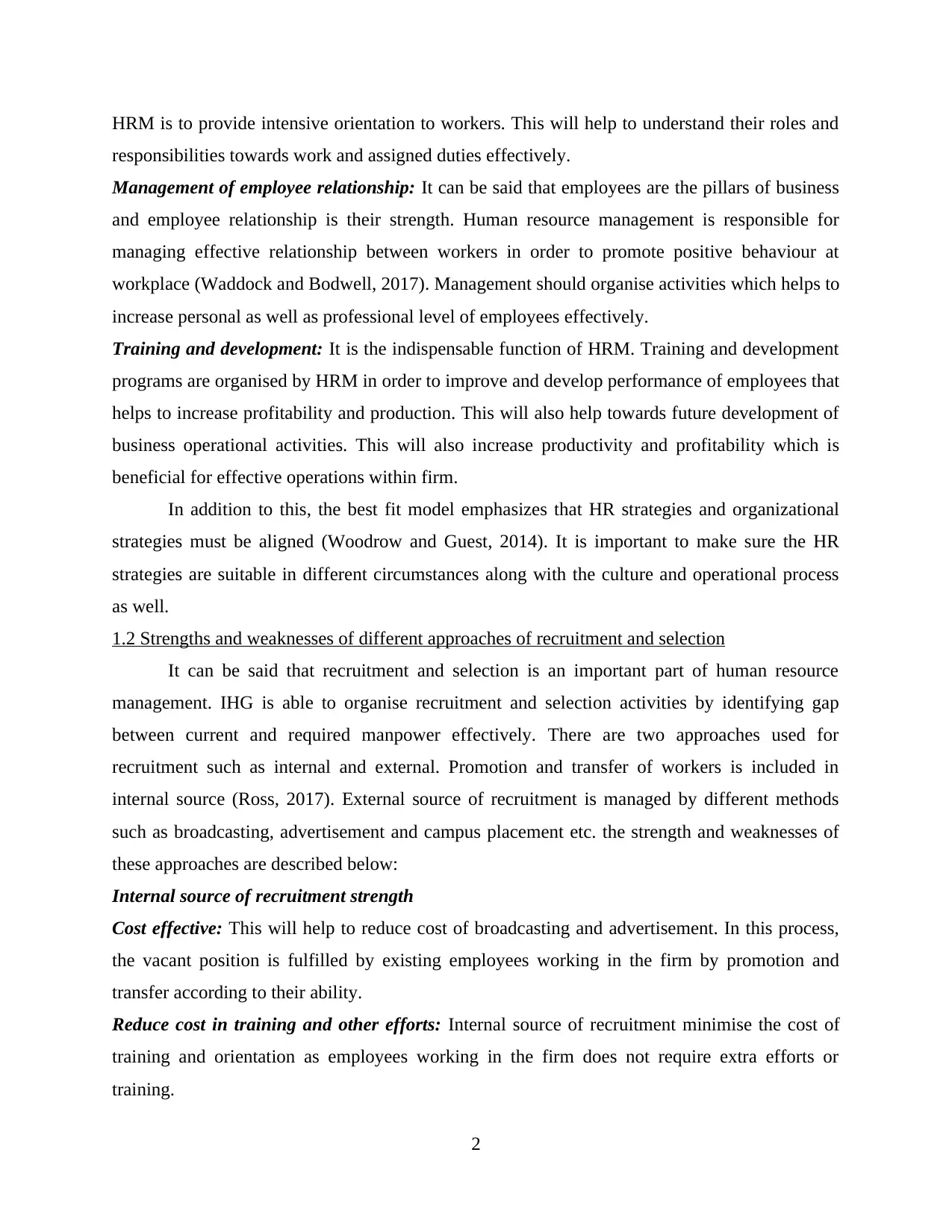
HRM is to provide intensive orientation to workers. This will help to understand their roles and
responsibilities towards work and assigned duties effectively.
Management of employee relationship: It can be said that employees are the pillars of business
and employee relationship is their strength. Human resource management is responsible for
managing effective relationship between workers in order to promote positive behaviour at
workplace (Waddock and Bodwell, 2017). Management should organise activities which helps to
increase personal as well as professional level of employees effectively.
Training and development: It is the indispensable function of HRM. Training and development
programs are organised by HRM in order to improve and develop performance of employees that
helps to increase profitability and production. This will also help towards future development of
business operational activities. This will also increase productivity and profitability which is
beneficial for effective operations within firm.
In addition to this, the best fit model emphasizes that HR strategies and organizational
strategies must be aligned (Woodrow and Guest, 2014). It is important to make sure the HR
strategies are suitable in different circumstances along with the culture and operational process
as well.
1.2 Strengths and weaknesses of different approaches of recruitment and selection
It can be said that recruitment and selection is an important part of human resource
management. IHG is able to organise recruitment and selection activities by identifying gap
between current and required manpower effectively. There are two approaches used for
recruitment such as internal and external. Promotion and transfer of workers is included in
internal source (Ross, 2017). External source of recruitment is managed by different methods
such as broadcasting, advertisement and campus placement etc. the strength and weaknesses of
these approaches are described below:
Internal source of recruitment strength
Cost effective: This will help to reduce cost of broadcasting and advertisement. In this process,
the vacant position is fulfilled by existing employees working in the firm by promotion and
transfer according to their ability.
Reduce cost in training and other efforts: Internal source of recruitment minimise the cost of
training and orientation as employees working in the firm does not require extra efforts or
training.
2
responsibilities towards work and assigned duties effectively.
Management of employee relationship: It can be said that employees are the pillars of business
and employee relationship is their strength. Human resource management is responsible for
managing effective relationship between workers in order to promote positive behaviour at
workplace (Waddock and Bodwell, 2017). Management should organise activities which helps to
increase personal as well as professional level of employees effectively.
Training and development: It is the indispensable function of HRM. Training and development
programs are organised by HRM in order to improve and develop performance of employees that
helps to increase profitability and production. This will also help towards future development of
business operational activities. This will also increase productivity and profitability which is
beneficial for effective operations within firm.
In addition to this, the best fit model emphasizes that HR strategies and organizational
strategies must be aligned (Woodrow and Guest, 2014). It is important to make sure the HR
strategies are suitable in different circumstances along with the culture and operational process
as well.
1.2 Strengths and weaknesses of different approaches of recruitment and selection
It can be said that recruitment and selection is an important part of human resource
management. IHG is able to organise recruitment and selection activities by identifying gap
between current and required manpower effectively. There are two approaches used for
recruitment such as internal and external. Promotion and transfer of workers is included in
internal source (Ross, 2017). External source of recruitment is managed by different methods
such as broadcasting, advertisement and campus placement etc. the strength and weaknesses of
these approaches are described below:
Internal source of recruitment strength
Cost effective: This will help to reduce cost of broadcasting and advertisement. In this process,
the vacant position is fulfilled by existing employees working in the firm by promotion and
transfer according to their ability.
Reduce cost in training and other efforts: Internal source of recruitment minimise the cost of
training and orientation as employees working in the firm does not require extra efforts or
training.
2
Paraphrase This Document
Need a fresh take? Get an instant paraphrase of this document with our AI Paraphraser
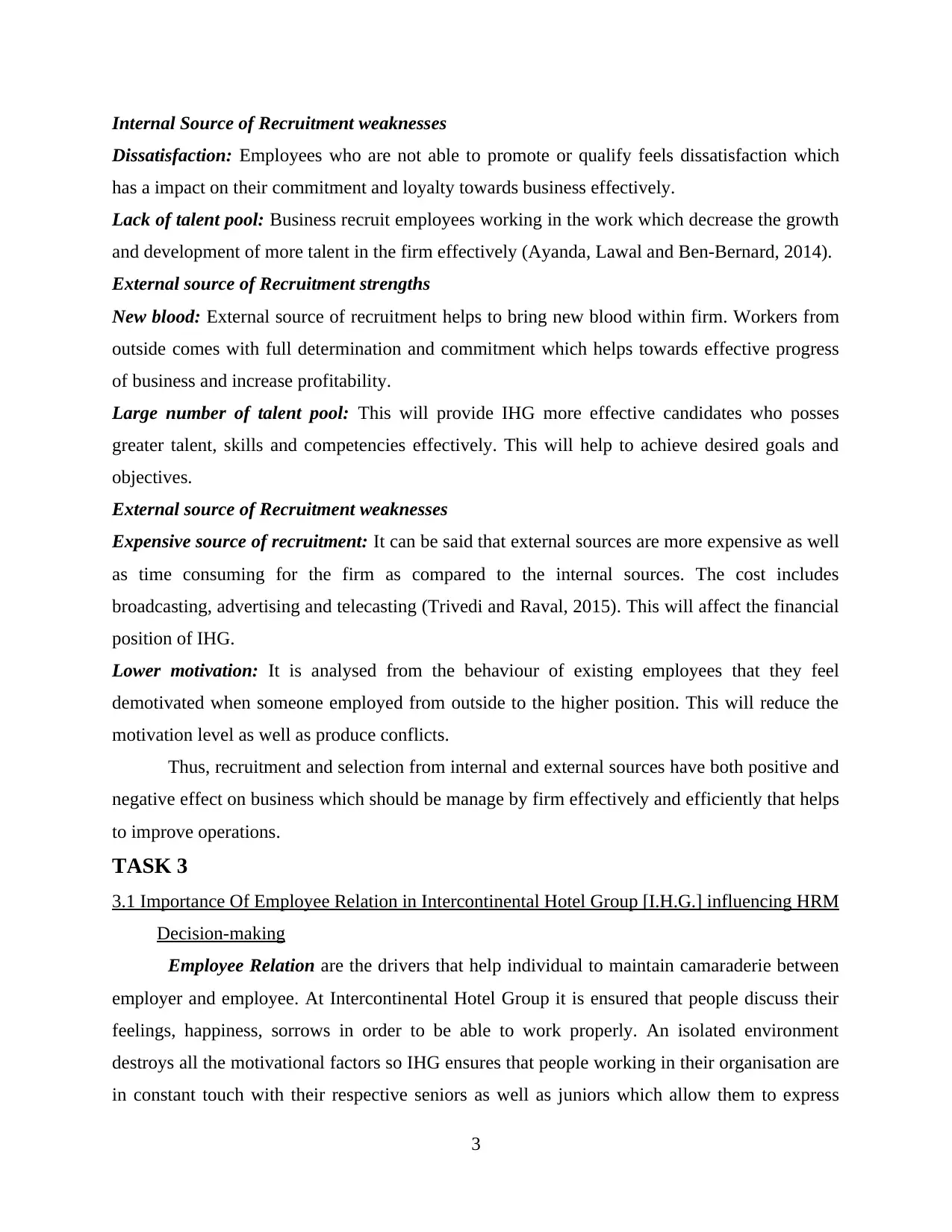
Internal Source of Recruitment weaknesses
Dissatisfaction: Employees who are not able to promote or qualify feels dissatisfaction which
has a impact on their commitment and loyalty towards business effectively.
Lack of talent pool: Business recruit employees working in the work which decrease the growth
and development of more talent in the firm effectively (Ayanda, Lawal and Ben-Bernard, 2014).
External source of Recruitment strengths
New blood: External source of recruitment helps to bring new blood within firm. Workers from
outside comes with full determination and commitment which helps towards effective progress
of business and increase profitability.
Large number of talent pool: This will provide IHG more effective candidates who posses
greater talent, skills and competencies effectively. This will help to achieve desired goals and
objectives.
External source of Recruitment weaknesses
Expensive source of recruitment: It can be said that external sources are more expensive as well
as time consuming for the firm as compared to the internal sources. The cost includes
broadcasting, advertising and telecasting (Trivedi and Raval, 2015). This will affect the financial
position of IHG.
Lower motivation: It is analysed from the behaviour of existing employees that they feel
demotivated when someone employed from outside to the higher position. This will reduce the
motivation level as well as produce conflicts.
Thus, recruitment and selection from internal and external sources have both positive and
negative effect on business which should be manage by firm effectively and efficiently that helps
to improve operations.
TASK 3
3.1 Importance Of Employee Relation in Intercontinental Hotel Group [I.H.G.] influencing HRM
Decision-making
Employee Relation are the drivers that help individual to maintain camaraderie between
employer and employee. At Intercontinental Hotel Group it is ensured that people discuss their
feelings, happiness, sorrows in order to be able to work properly. An isolated environment
destroys all the motivational factors so IHG ensures that people working in their organisation are
in constant touch with their respective seniors as well as juniors which allow them to express
3
Dissatisfaction: Employees who are not able to promote or qualify feels dissatisfaction which
has a impact on their commitment and loyalty towards business effectively.
Lack of talent pool: Business recruit employees working in the work which decrease the growth
and development of more talent in the firm effectively (Ayanda, Lawal and Ben-Bernard, 2014).
External source of Recruitment strengths
New blood: External source of recruitment helps to bring new blood within firm. Workers from
outside comes with full determination and commitment which helps towards effective progress
of business and increase profitability.
Large number of talent pool: This will provide IHG more effective candidates who posses
greater talent, skills and competencies effectively. This will help to achieve desired goals and
objectives.
External source of Recruitment weaknesses
Expensive source of recruitment: It can be said that external sources are more expensive as well
as time consuming for the firm as compared to the internal sources. The cost includes
broadcasting, advertising and telecasting (Trivedi and Raval, 2015). This will affect the financial
position of IHG.
Lower motivation: It is analysed from the behaviour of existing employees that they feel
demotivated when someone employed from outside to the higher position. This will reduce the
motivation level as well as produce conflicts.
Thus, recruitment and selection from internal and external sources have both positive and
negative effect on business which should be manage by firm effectively and efficiently that helps
to improve operations.
TASK 3
3.1 Importance Of Employee Relation in Intercontinental Hotel Group [I.H.G.] influencing HRM
Decision-making
Employee Relation are the drivers that help individual to maintain camaraderie between
employer and employee. At Intercontinental Hotel Group it is ensured that people discuss their
feelings, happiness, sorrows in order to be able to work properly. An isolated environment
destroys all the motivational factors so IHG ensures that people working in their organisation are
in constant touch with their respective seniors as well as juniors which allow them to express
3

themselves freely in a manner they wish too, in the process improving the communication within
the organisation (Chadwick, Super and Kwon, 2015).
Few notable importance are discussed below :-
Working becomes easy if its shared amongst all.
There are several issues on which an individual can't take decision alone so IHG has
made sure that people consult with each other before taking decision.
Organisation becomes a better place if people are working together as a group.
Employee always feel motivated when they have a support while performing their tasks.
Healthy employer-employee relation ensures less absenteeism and more focus on work in
hand. It is always advisable to have good relationship with co-workers, as you never know
when their need might arise.
Strategies For Improving Employee Relation :- Involving each member of team :- at IHG every member of the group is involved in the
process of completion of any task, ensuring various feedbacks on how a task could be
accomplished. Encourage individual to share work :- this results in bonding amongst people, as now
they are working together and not separately to complete a task. Initiate effective communication within the team :- if a person is facing any problem he
should be able to communicate the same to its peers and co-workers so that the problem
is resolved soon (Cardy and Leonard, 2014). At IHG special emphasis is conducted on
maintaining effective communication. Morning meeting is another way to improve employee relation :- during these meetings
everyone sits around the same table, enjoy a cup of coffee, talk about things they should
do in order to effectively manage the task. This makes sure that people are coming
together to consult each other to do well.
Assigning every group member equal task :- this would ensure that people achieve
individual targets and make sure that their group is also on the right track. It would result
in people trusting each other and working together, allowing transparency of work and
timely completion.
4
the organisation (Chadwick, Super and Kwon, 2015).
Few notable importance are discussed below :-
Working becomes easy if its shared amongst all.
There are several issues on which an individual can't take decision alone so IHG has
made sure that people consult with each other before taking decision.
Organisation becomes a better place if people are working together as a group.
Employee always feel motivated when they have a support while performing their tasks.
Healthy employer-employee relation ensures less absenteeism and more focus on work in
hand. It is always advisable to have good relationship with co-workers, as you never know
when their need might arise.
Strategies For Improving Employee Relation :- Involving each member of team :- at IHG every member of the group is involved in the
process of completion of any task, ensuring various feedbacks on how a task could be
accomplished. Encourage individual to share work :- this results in bonding amongst people, as now
they are working together and not separately to complete a task. Initiate effective communication within the team :- if a person is facing any problem he
should be able to communicate the same to its peers and co-workers so that the problem
is resolved soon (Cardy and Leonard, 2014). At IHG special emphasis is conducted on
maintaining effective communication. Morning meeting is another way to improve employee relation :- during these meetings
everyone sits around the same table, enjoy a cup of coffee, talk about things they should
do in order to effectively manage the task. This makes sure that people are coming
together to consult each other to do well.
Assigning every group member equal task :- this would ensure that people achieve
individual targets and make sure that their group is also on the right track. It would result
in people trusting each other and working together, allowing transparency of work and
timely completion.
4
⊘ This is a preview!⊘
Do you want full access?
Subscribe today to unlock all pages.

Trusted by 1+ million students worldwide

3.2 Elements of Employee Legislation and its Impact on HRM Decision Making
Employee Legislation refers to a set of rules, regulations, rights and duties attached to
any profession. At IHG it is ensured that employee's rights are clearly taken care of and also
employee's make sure that they are not indulging in any malpractices hampering companies
image (Collings, 2014). There are several elements within employee legislation which human
resource manager needs to address before making any remarks or decision, they are :- Equality :- every individual working in an organisation expects to be given the same and
fair treatment like his peers are getting, if there is any inequality observed it will result in
dissatisfaction amongst employee's and could result in chaos and mismanagement. Data Protection :- most of the people working within an organisation are trusted with
handling the database. It is expected that they take full care while managing it and no
classified information is leaked, leading to losses to company. There are certain laws
placed if people are found guilty of leaking important data to others. Health and Safety :- every individual employed with IHG is been taken proper care of
with respect to health and safety. They are provided ample safety in their working
environment (Schoorman, Mayer and Davis, 2016). Working Time and Child Care :- there is particular time frame for which people have to
work and employer makes sure that employee completes his work in time. Employee's at
IHG are never forced to work beyond their time but are encouraged to complete work on
time. The people employed with IHG are provided with several child care facilities so
that they feel a sense of responsibility towards the organisation which takes care of their
families. Wage Regulation :- at IHG proper wage structure is followed according to the hierarchy
of positions at which people are employed and proper remuneration and promotions are
given based on their performance. This enables proper wage regulation within
organisation. Civil Liberties At Work :- it refers to rights available at working place. People working
with IHG have all the civil rights and they can make complaints with company as well as
law authority in case of violation of those basic civil rights available to them.
Income Tax and Insurance :- every individual employed with IHG needs to make a
payment towards income tax which is deducted from their respective salaries (Festing
5
Employee Legislation refers to a set of rules, regulations, rights and duties attached to
any profession. At IHG it is ensured that employee's rights are clearly taken care of and also
employee's make sure that they are not indulging in any malpractices hampering companies
image (Collings, 2014). There are several elements within employee legislation which human
resource manager needs to address before making any remarks or decision, they are :- Equality :- every individual working in an organisation expects to be given the same and
fair treatment like his peers are getting, if there is any inequality observed it will result in
dissatisfaction amongst employee's and could result in chaos and mismanagement. Data Protection :- most of the people working within an organisation are trusted with
handling the database. It is expected that they take full care while managing it and no
classified information is leaked, leading to losses to company. There are certain laws
placed if people are found guilty of leaking important data to others. Health and Safety :- every individual employed with IHG is been taken proper care of
with respect to health and safety. They are provided ample safety in their working
environment (Schoorman, Mayer and Davis, 2016). Working Time and Child Care :- there is particular time frame for which people have to
work and employer makes sure that employee completes his work in time. Employee's at
IHG are never forced to work beyond their time but are encouraged to complete work on
time. The people employed with IHG are provided with several child care facilities so
that they feel a sense of responsibility towards the organisation which takes care of their
families. Wage Regulation :- at IHG proper wage structure is followed according to the hierarchy
of positions at which people are employed and proper remuneration and promotions are
given based on their performance. This enables proper wage regulation within
organisation. Civil Liberties At Work :- it refers to rights available at working place. People working
with IHG have all the civil rights and they can make complaints with company as well as
law authority in case of violation of those basic civil rights available to them.
Income Tax and Insurance :- every individual employed with IHG needs to make a
payment towards income tax which is deducted from their respective salaries (Festing
5
Paraphrase This Document
Need a fresh take? Get an instant paraphrase of this document with our AI Paraphraser

and Schäfer, 2014). They are provided health insurance from the company which
includes basic health remedies.
CONCLUSION
It can be concluded from the above report that human resource department is responsible
for managing all the activities including payroll, hiring, firing, benefits and keeping updates of
federal tax laws and other policies. In addition to this, recruitment and selection is an important
part of human resource management as well as internal and external sources which have both
positive and negative effect on business which should be managed by firm effectively. Employee
Relation are the drivers that help individual to maintain camaraderie between employer and
employee. It is analysed from the report that employee Legislation refers to a set of rules,
regulations, rights and duties attached to any profession. There are several elements within
employee legislation which human resource manager needs to address before making any
remarks or decision.
6
includes basic health remedies.
CONCLUSION
It can be concluded from the above report that human resource department is responsible
for managing all the activities including payroll, hiring, firing, benefits and keeping updates of
federal tax laws and other policies. In addition to this, recruitment and selection is an important
part of human resource management as well as internal and external sources which have both
positive and negative effect on business which should be managed by firm effectively. Employee
Relation are the drivers that help individual to maintain camaraderie between employer and
employee. It is analysed from the report that employee Legislation refers to a set of rules,
regulations, rights and duties attached to any profession. There are several elements within
employee legislation which human resource manager needs to address before making any
remarks or decision.
6

REFERENCES
Books and Journals
Ayanda, A.M., Lawal, O.R. and Ben-Bernard, P., 2014. Effects of human resource management
practices on financial performance of banks. Transnational Journal of Science and
Technology 4(2).
Bargiela-Chiappini, F., 2014. Meaning creation and genre across cultures: human resource
management magazines in Britain and Italy. In Writing Business (pp. 147-170).
Routledge.
Cardy, R. and Leonard, B., 2014. Performance Management: Concepts, Skills and Exercises:
Concepts, Skills and Exercises. Routledge.
Chadwick, C., Super, J.F. and Kwon, K., 2015. Resource orchestration in practice: CEO
emphasis on SHRM, commitment‐based HR systems, and firm performance. Strategic
Management Journal 36(3) pp.360-376.
Collings, D.G., 2014. Integrating global mobility and global talent management: Exploring the
challenges and strategic opportunities. Journal of World Business 49(2) pp.253-261.
Festing, M. and Schäfer, L., 2014. Generational challenges to talent management: A framework
for talent retention based on the psychological-contract perspective. Journal of World
Business 49(2) pp.262-271.
Iglesias, O. and Saleem, F.Z., 2015. How to support consumer-brand relationships: The role of
corporate culture and human resource policies and practices. Marketing Intelligence &
Planning 33(2) pp.216-234.
Ross, J.E., 2017. Total quality management: Text, cases, and readings. Routledge.
Schoorman, F.D., Mayer, R.C. and Davis, J.H., 2016. Perspective: Empowerment in veterinary
clinics: the role of trust in delegation. Journal of Trust Research 6(1) pp.91-95.
Trivedi, S. and Raval, D., 2015. Review of literature on the study of linkage between human
resource management practices and organizational performance. International
Journal 3(6) pp.314-323.
Waddock, S. and Bodwell, C., 2017. Total responsibility management: The manual. Routledge.
Woodrow, C. and Guest, D.E., 2014. When good HR gets bad results: Exploring the challenge of
HR implementation in the case of workplace bullying. Human Resource Management
Journal 24(1) pp.38-56.
7
Books and Journals
Ayanda, A.M., Lawal, O.R. and Ben-Bernard, P., 2014. Effects of human resource management
practices on financial performance of banks. Transnational Journal of Science and
Technology 4(2).
Bargiela-Chiappini, F., 2014. Meaning creation and genre across cultures: human resource
management magazines in Britain and Italy. In Writing Business (pp. 147-170).
Routledge.
Cardy, R. and Leonard, B., 2014. Performance Management: Concepts, Skills and Exercises:
Concepts, Skills and Exercises. Routledge.
Chadwick, C., Super, J.F. and Kwon, K., 2015. Resource orchestration in practice: CEO
emphasis on SHRM, commitment‐based HR systems, and firm performance. Strategic
Management Journal 36(3) pp.360-376.
Collings, D.G., 2014. Integrating global mobility and global talent management: Exploring the
challenges and strategic opportunities. Journal of World Business 49(2) pp.253-261.
Festing, M. and Schäfer, L., 2014. Generational challenges to talent management: A framework
for talent retention based on the psychological-contract perspective. Journal of World
Business 49(2) pp.262-271.
Iglesias, O. and Saleem, F.Z., 2015. How to support consumer-brand relationships: The role of
corporate culture and human resource policies and practices. Marketing Intelligence &
Planning 33(2) pp.216-234.
Ross, J.E., 2017. Total quality management: Text, cases, and readings. Routledge.
Schoorman, F.D., Mayer, R.C. and Davis, J.H., 2016. Perspective: Empowerment in veterinary
clinics: the role of trust in delegation. Journal of Trust Research 6(1) pp.91-95.
Trivedi, S. and Raval, D., 2015. Review of literature on the study of linkage between human
resource management practices and organizational performance. International
Journal 3(6) pp.314-323.
Waddock, S. and Bodwell, C., 2017. Total responsibility management: The manual. Routledge.
Woodrow, C. and Guest, D.E., 2014. When good HR gets bad results: Exploring the challenge of
HR implementation in the case of workplace bullying. Human Resource Management
Journal 24(1) pp.38-56.
7
⊘ This is a preview!⊘
Do you want full access?
Subscribe today to unlock all pages.

Trusted by 1+ million students worldwide

8
1 out of 10
Related Documents
Your All-in-One AI-Powered Toolkit for Academic Success.
+13062052269
info@desklib.com
Available 24*7 on WhatsApp / Email
![[object Object]](/_next/static/media/star-bottom.7253800d.svg)
Unlock your academic potential
Copyright © 2020–2025 A2Z Services. All Rights Reserved. Developed and managed by ZUCOL.





